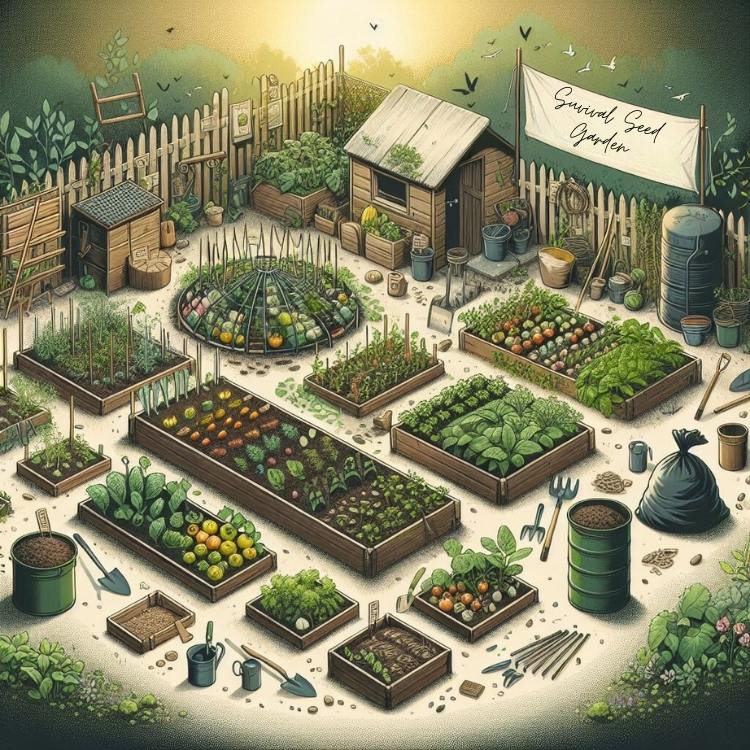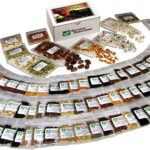
When the unexpected happens, and the world as we know it is turned on its head, having a plan in place can make all the difference. One of the most empowering plans you can have is creating a survival seed garden. This isn’t just about growing plants; it’s about cultivating a lifeline that can sustain you and your loved ones when grocery store shelves are empty and food supplies are uncertain.
Key Takeaways: Survival Seed Gardens
- Survival seed gardens provide a dependable food source during emergencies.
- Heirloom seeds are ideal for survival gardens due to their resilience and seed-saving capability.
- Choosing the right seeds involves considering your climate and nutritional needs.
- Planning your garden includes understanding your space, soil, and sunlight availability.
- Seed saving is crucial for a sustainable garden and future planting.
Unlocking the Power of Survival Seed Gardens
What Are Survival Seed Gardens?
Imagine your backyard not just as a space for relaxation, but as a powerhouse of nutrition that can keep you going when times get tough. A survival seed garden is designed for just that. It’s a garden packed with plants specifically chosen for their ability to provide a steady supply of food in the event of an emergency. These aren’t your average garden varieties, but carefully selected seeds that can handle a range of conditions and still produce the food you need.
Why They’re a Game-Changer in Emergencies
When disaster strikes, access to fresh, healthy food can become a luxury. Survival seed gardens are a game-changer because they offer autonomy. You’re not just waiting for help; you’re actively securing your nutritional needs. They’re a source of food that doesn’t require a trip to the store, which is vital if transportation is disrupted or if you’re trying to avoid exposure to danger.
The Benefits of Growing Your Own Resilience

Nutrition Security During Crises
In an emergency, your body’s need for nutrients increases due to stress and the potential for increased physical activity. A survival seed garden ensures that you have access to vitamins, minerals, and calories when you need them most. Besides that, knowing you have a source of nutrition can ease mental stress during challenging times.
Reducing Dependence on Outside Resources
One of the most empowering aspects of a survival seed garden is the reduction of dependency on outside resources. When supply chains are interrupted, a personal garden becomes a crucial buffer. It allows you to be self-reliant and less affected by external shortages or price hikes.
Preserving Heirloom Varieties for Future Stability
By focusing on heirloom varieties, you’re not just growing food for now; you’re preserving genetic diversity for the future. These plants have stood the test of time and are often more adaptable to local conditions than modern hybrids. Most importantly, they can be seed-savers, meaning you can collect seeds for next season, ensuring a continuous food supply.
- Start with resilient heirloom varieties that can grow in your climate.
- Plan your garden layout to maximize space and sunlight exposure.
- Learn the basics of seed saving to ensure a perpetual food supply.
Now, let’s dive deeper into how to choose the right seeds and plan your survival garden for optimum yield and sustainability.
Drought-Resistant and Nutrient-Dense Plant Selection
When you’re picking seeds for your survival garden, two things are key: how well the plants can withstand drought and their nutritional value. You want plants that can survive with minimal water because, let’s face it, we can’t always predict the weather. Nutrient-dense plants are also crucial because they pack more vitamins and minerals into each bite, which is essential when you’re trying to make the most of your garden space.
Planning and Planting Your Emergency Food Source

The first step in planning your survival garden is to assess your space. Whether you have a sprawling backyard or just a few containers on a balcony, you need to understand the potential of your growing area. Think vertical gardening for small spaces, and for larger areas, consider the most efficient layout to maximize your crop yield.
Next, test your soil. Most plants prefer a neutral pH, but some, like blueberries, love acidic conditions. If you’re unsure, local extension services often offer soil testing for a small fee. Amend your soil accordingly, with compost to add nutrients, or sand to improve drainage if needed.
Finally, consider sunlight. Most vegetables need at least six hours of direct sunlight per day. If your space doesn’t get enough sun, focus on leafy greens or root vegetables that can tolerate partial shade. Remember, the sun’s path changes throughout the year, so observe the patterns to choose the best spots for your plants.
Example: If you’re working with a small balcony, choose compact varieties like ‘Patio Princess’ tomatoes or ‘Little Finger’ carrots. Use hanging baskets for strawberries and vertical trellises for peas and beans to make the most of your vertical space.
Location, Soil, and Sunlight: The Basics of Setup
Think of your garden’s location as its foundation. You want a spot that’s easily accessible for you but not for pests. The soil is your garden’s bedrock. It needs to be rich in organic matter, well-draining, and alive with worms and beneficial microbes. And sunlight? It’s the energy that fuels your plants’ growth. Without enough light, your plants won’t produce as much food, and what they do produce won’t be as nutritious.
But what if your ideal spot isn’t perfect? Don’t worry. With a bit of creativity and effort, you can overcome almost any challenge. Raised beds can solve poor soil problems, and strategic plant placement can maximize light exposure. The key is to work with what you’ve got and to be willing to adapt.
For those with limited outdoor space, don’t overlook the potential of windowsills and patios. Even the smallest of areas can yield impressive results with the right approach. And if you’re in an urban environment, look into community gardens where you can grow food and learn from others.
Example: Sarah’s backyard had heavy clay soil, which was far from ideal. She built raised beds and filled them with a mix of compost, vermiculite, and peat moss. Her garden thrived, and she learned an important lesson: with the right preparation, any space can become a productive survival garden.
Maximizing Yield in Limited Spaces
Not everyone has acres of land for farming, but that doesn’t mean you can’t grow a substantial amount of food. Square foot gardening, for instance, is a method that divides the growing area into small square sections to optimize space and yield. It’s perfect for those with limited room.
Another technique is succession planting, where you plant new crops as soon as one is harvested. This keeps your garden productive all season long. Also, consider companion planting, which involves growing plants together that benefit each other, like tomatoes and basil.
Maintaining Your Garden with Minimal Resources
Water is precious, especially in a survival scenario. Collect rainwater if possible, and use mulch to retain soil moisture. When it comes to fertilizing, homemade compost is your best friend. It’s free and reduces waste while improving soil health.
Pests can be managed without chemicals by encouraging beneficial insects, using barriers like row covers, and practicing crop rotation to prevent soil-borne diseases. Remember, a healthy garden is the best defense against pests and diseases.
Lastly, keep your tools simple. A spade, a hoe, and a watering can are the basics. The less you rely on fancy gadgets, the more resilient your gardening practice will be.
- Use mulch to conserve water and suppress weeds.
- Create compost from kitchen scraps and yard waste to enrich the soil.
- Practice manual pest control methods, like handpicking and using barriers.
- Choose tools that don’t require fuel or electricity to ensure they’re always operational.
By adopting these practices, you’ll create a garden that’s not only productive but also sustainable and resilient, capable of providing for you no matter what the future holds.
From Garden to Table: Utilizing Your Harvest
Once your garden is in full swing, you’ll need to know how to harvest and use your bounty. The key is to pick vegetables when they’re at their peak for the best flavor and nutrition. Learn how to store your harvest properly to extend its shelf life, whether that’s in a root cellar, through canning, or by drying herbs.
But growing the food is only half the battle. You’ll also need to know how to prepare it. A survival garden should include plants that provide a range of flavors and textures, so you can make meals that are not just nutritious but also enjoyable to eat.
Harvesting Techniques to Maximize Shelf-Life
Timing is everything when it comes to harvesting. Pick leafy greens early in the morning when they’re most hydrated. For vegetables like tomatoes and cucumbers, wait until they’re fully ripe to get the most out of their natural shelf life. And when you harvest root crops, leave them in the ground until you’re ready to eat them to keep them fresh.
Simple yet Nutritious Survival Recipes
Survival food doesn’t have to be bland. With a variety of plants in your garden, you can create dishes that are both satisfying and healthy. For example, a simple stew made from your garden’s produce can be both comforting and packed with nutrients. Fresh herbs can add flavor to any dish, transforming even the simplest meal into something special.
Remember, the key to cooking with your garden’s harvest is flexibility. Don’t be afraid to substitute ingredients and experiment with flavors. The more you cook with what you grow, the better you’ll become at creating delicious, resourceful meals.
Passing It On: Seed Saving for Continuity

One of the most crucial aspects of a survival seed garden is the ability to save seeds for future planting. This practice ensures that you’ll have a continuous supply of food without the need to purchase new seeds each season. It’s also a way to adapt your plants to your specific growing conditions, making them more resilient over time.
Creating a Community Seed Bank
Sharing is caring, especially when it comes to ensuring food security within your community. A community seed bank is a collective treasure chest, storing seeds that can be used by everyone to grow their own survival gardens. It’s about pooling resources, sharing knowledge, and fostering a spirit of cooperation that can be lifesaving in times of need.
Starting a community seed bank begins with collaboration. Reach out to neighbors, local gardening clubs, and schools to gauge interest. Once you have a group, you can begin collecting heirloom seeds. Each member can grow different varieties and contribute a portion of their seeds back to the bank. This not only diversifies the available seeds but also strengthens the community bond.
Frequently Asked Questions
Here are some answers to common questions about starting and maintaining a survival seed garden. These tips can help you overcome obstacles and ensure your garden is a success.
How Do I Start a Survival Seed Garden with Limited Space?
Starting a survival seed garden in a small space requires creativity. Look for compact plant varieties and consider vertical gardening options like trellises or hanging baskets. Container gardening is also a fantastic way to grow a variety of crops in a limited area. Utilize balconies, patios, and even window sills to maximize your growing potential.
Remember, the goal is to grow high-yield crops that require minimal space. Plants like tomatoes, peppers, and herbs can be quite productive in pots or other containers. And don’t forget about microgreens, which can be grown indoors and are packed with nutrients.
Example: Lisa transformed her tiny apartment balcony into a mini survival garden using containers. She grew cherry tomatoes, lettuce, and a variety of herbs. Despite the limited space, she was able to harvest fresh produce throughout the season.
With a bit of ingenuity, you can turn any small space into a thriving survival seed garden that provides fresh food and peace of mind.
Can I Grow a Survival Garden If I Live in an Urban Area?
- Utilize any available outdoor space, such as balconies or rooftops, for container gardening.
- Investigate community gardens where you can rent a plot and grow food.
- Consider indoor gardening with the help of grow lights for herbs and smaller vegetables.
- Look into hydroponic or aquaponic systems that can fit into urban living spaces.
Urban environments have unique challenges, but with a bit of creativity, you can cultivate a lush garden that provides fresh produce. The key is to maximize the use of vertical space and to choose plants that can thrive in containers.
Don’t let the concrete jungle discourage you. Instead, let it inspire innovative ways to grow food and become more self-sufficient.
Urban survival gardens not only provide food security but also contribute to greening the city and improving air quality, making them a win-win for everyone.
Joining a community garden can also provide you with the space and resources to grow a more extensive range of vegetables, along with the opportunity to learn from more experienced gardeners.
What Are the Most Crucial Seeds to Include in a Survival Garden?
The most important seeds for your survival garden are those that will provide you with a balanced diet and can be easily saved for future planting. These include:
- High-calorie staples like potatoes, corn, and beans for energy.
- Nutrient-rich greens such as spinach, kale, and Swiss chard for vitamins and minerals.
- Herbs like basil, parsley, and cilantro for flavor and medicinal properties.
- Heirloom tomato and pepper seeds for their versatility and high yield.
- Squash and melons, which can be stored for extended periods.
When choosing seeds, consider the growing conditions in your area and select varieties that are known to thrive there. This will give you the best chance of a bountiful harvest.
How Do I Manage Pests without Chemicals in a Survival Garden?
Managing pests without chemicals is all about prevention and natural remedies. Start by selecting disease-resistant plant varieties and keep your garden clean by removing any diseased plants or fallen debris. Encourage beneficial insects that prey on pests by planting flowers like marigolds or herbs such as dill and fennel.
Physical barriers like row covers can protect your plants from insects and birds. If you do encounter pests, handpicking them or using a strong jet of water to knock them off the plants can be effective. For a natural insecticide, a solution of water and neem oil or insecticidal soap can help control many common garden pests.
How Can I Ensure My Survival Garden Is Sustainable?
To ensure your survival garden is sustainable, focus on soil health, water conservation, and seed saving. A healthy soil rich in organic matter will support plant growth year after year. Use compost to enrich your soil, and mulch to conserve moisture and suppress weeds. Collecting rainwater can also help you maintain your garden during dry spells.
Seed saving is perhaps the most critical aspect of a sustainable garden. By saving seeds from your best plants, you’re selecting for traits that are well-suited to your specific growing conditions. Over time, this will result in a garden that is increasingly resilient and productive.
By following these practices, your survival seed garden can become a perpetual source of food and security, ensuring that you and your community can weather any storm.
Remember, the knowledge you gain through creating and maintaining a survival seed garden is just as valuable as the food it produces. You’re not only growing plants; you’re growing resilience. By sharing this knowledge and these resources, you’re helping to build a community that can stand strong in the face of adversity. So why not take the first step today and learn more about how you can make a difference with a survival seed garden?






